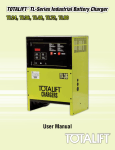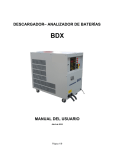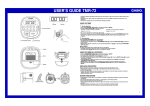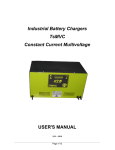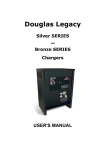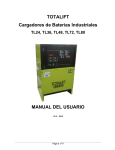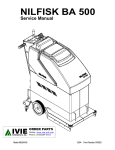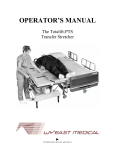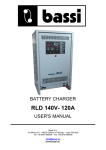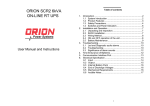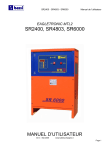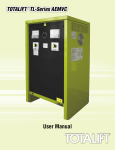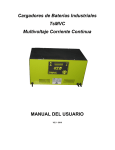Download TOTALIFT Industrial Battery Chargers USER`S MANUAL
Transcript
TOTALIFT Industrial Battery Chargers TL24, TL36, TL48, TL72, TL80 USER'S MANUAL V2.3 – 2010 __________________________________________________________________________________________________________________________________________________ Page 1/16 INDEX 1. Safety Instructions and Warnings……………………………….. 3 General………………………………………………………………. 3 Shock Prevention…………………………………………………… 3 Burn and Bodily Injury Prevention………………………………… 4 Fire and Explosion Prevention…………………………………….. 4 Arcing and Burning of Connector………………………………….. 4 Medical and First Aid Treatment………………………………….... 4 2. Description of The Charger…………………………………………4 3. Installation of The Charger………………………………………… 5 AC Input Connection……………………………………………….. 7 AC Input Voltage Selection …………………………………………. 7 AC Input Voltage Settings………………………………………….. 8 4. How to Use The Charger………………………………………… 8 Programming the Gassing Point………..……………………… 8 Battery Connection-Automatic Voltage Check and Auto Start…. 10 Charge Operation…………………………………………………… 10 Safety Timer-Emergency Stop…………………………………….. 12 Automatic Data Savings……………………………………………. 12 Blown Fuse Detection …………………………………………... 12 Automatic Charge Termination……………………………………. 13 Shut Down on Battery Disconnect…………………………………. 13 Equalization & Refresh Modes………………………………….. 14 Manual Charge Termination……………………………………… 16 __________________________________________________________________________________________________________________________________________________ Page 2/16 1. SAFETY INSTRUCTIONS AND WARNINGS Before using your TOTALIFT battery charger, please take the time to read these instructions carefully. The owner’s manual is an important part of the charger. It’s recommended to keep it in good condition for the lifetime of the charger. It should be kept in a dry and clean place, always available to the users. To indicate important instructions, the following blocks are used throughout this manual. CAUTION! This operation can be dangerous for the user. ATTENTION! This operation is important for the functionality and reliability of the charger. GENERAL Battery charging products can cause serious injury or death, or damage to other equipment or property, if the operator does not strictly observe all safety rules and take precautionary actions. Safe practices must be learned through study and training before using this equipment. Only qualified personnel should install, use, or service this equipment. SHOCK PREVENTION Bare conductors or terminals in the output circuit, or ungrounded, electrically-live equipment can fatally shock a person. To protect against shock, have a certified electrician verify that the equipment is adequately grounded and identify what terminals and parts are electrically HOT. The body’s electrical resistance is decreased when wet, permitting dangerous current to flow through the body. Do not work in a damp area without being extremely careful. Stand on a dry rubber mat or dry wood and use insulating gloves when dampness or sweat cannot be avoided. Keep clothing dry. INSTALLATION AND GROUNDING - A power disconnect switch must be located at the equipment. Check the data label for voltage and phase requirements. If only 3-phase power is available, connect single-phase equipment to ONLY TWO WIRES of the 3-phase line. DO NOT CONNECT the equipment grounding conductor to the third live wire of the 3-phase line as this makes the equipment frame electrically HOT, which can cause a fatal shock. If a grounding conductor is part of the power supply cable, be sure to connect it to a properly grounded switch box or building ground. If not part of the supply cable, use a separate grounding conductor. Don’t remove a ground prong from any plug. Use correct mating receptacles. Check ground for electrical continuity before using equipment. The grounding conductor must be of a size equal to or larger than the size of the line conductors. CHARGING LEADS – Inspect leads often for damage to the insulation. Replace or repair cracked or worn leads immediately. Use leads having sufficient capacity to carry the operating current without overheating. BATTERY TERMINALS – Do not touch the battery terminals while equipment is operating. SERVICE AND MAINTENANCE – Shut OFF all power at the disconnect switch or line breaker BEFORE inspecting, adjusting, or servicing the equipment. Lock switch OPEN (or remove line fuses) so that the power cannot be turned ON accidentally. __________________________________________________________________________________________________________________________________________________ Page 3/16 Disconnect power to equipment if it is to be left unattended or out of service. Disconnect battery from charger. Keep inside parts clean and dry. Dirt and/or moisture can cause insulation failure. This failure can result in high voltage at the charger output. BURN AND BODILY INJURY PREVENTION The battery produces very high currents when short circuited, and will burn the skin severely if in contact with any metal conductor that is carrying this current. Do not permit rings on fingers to come in contact with battery terminals or the cell connectors on top of the battery. Battery acid is very corrosive. Always wear correct eye and body protection when near batteries. FIRE AND EXPLOSION PREVENTION When batteries are being recharged, they generate hydrogen gas that is explosive in certain concentrations in air (the flammability or explosive limits are 4.1% to 72% hydrogen in air). The spark-retarding vents help slow the rate of release of hydrogen, but the escaping hydrogen may form an explosive atmosphere around the battery if ventilation is poor. The ventilation system should be designed to provide an adequate amount of fresh air for the number of batteries being charged. This is essential to prevent an explosion. Always keep sparks, flames, burning cigarettes, and other sources of ignition away from the battery recharging area. Do not break "live" circuits at the terminals of batteries. Do not lay tools or anything that is metallic on top of any battery. ARCING AND BURNING OF CONNECTOR To prevent arcing and burning of the connector contacts, be sure the charger is OFF before connecting or disconnecting the battery. The ammeter should NOT indicate current flow. MEDICAL AND FIRST AID TREATMENT First aid facilities and a qualified first aid person should be available for each shift for immediate treatment of electrical shock victims. EMERGENCY FIRST AID: Call physician and ambulance immediately and use First Aid techniques recommended by the American Red Cross. DANGER: ELECTRICAL SHOCK CAN BE FATAL. If person is unconscious and electric shock is suspected, do not touch the person if he or she is in contact with charging equipment, battery, charging leads, or other live electrical parts. Disconnect power at wall switch and then use First Aid. Dry wood, wooden broom and other insulating material can be used to move cables, if necessary, away from the person. IF BREATHING IS DIFFICULT, give oxygen. IF NOT BREATHING, BEGIN ARTIFICIAL BREATHING, such as mouth-to-mouth. IF PULSE IS ABSENT, BEGIN ARTIFICIAL CIRCULATION, such as external heart massage. In case of acid in the eyes, flush very well with clean water and obtain professional medical attention immediately. 2. DESCRIPTION OF THE CHARGER TOTALIFT battery chargers have been designed to charge Lead-Acid batteries. These units convert the AC input to a DC output at the correct voltage. The charge curve is of the type Wa. __________________________________________________________________________________________________________________________________________________ Page 4/16 The operation of the TOTALIFT chargers is managed by the new MTL2 Digital Charge Controller, which is a microprocessor based electronic board of the latest generation. Important features of the MTL2 Digital charge controller are: Easy Programming by DIP switches. Programmable Gassing Voltage. Proportional Algorithm for charge time calculation. Programmable Equalize System (Automatic Pulsed & Manual). Automatic voltage-controlled maintenance. Wrong battery detection. Battery desulphation cycle. Independent safety timer. Automatic data-saving in case of black out of the mains. Cyclical indication of V/cell, AMPS, Ah returned, time. Cool down time counter. Scrolling messages in plain text. The MTL2 Charge Controller monitors the entire charging curve, and it incorporates several safety features. The front panel of the MTL2 Digital charge controller contains the digital display (4-Digits), the STOP button and the MANUAL-EQUALIZE button. 3. INSTALLATION OF THE CHARGER Conditions of use: Operating temperature: Storage temperature: Relative humidity: 5°C to 45°C -20°C to 60°C less than 75% __________________________________________________________________________________________________________________________________________________ Page 5/16 CAUTION! Risk of electrical shock! The charger can be installed by qualified personnel only. To prevent fire or shock hazard, do not expose the unit to rain or moisture. Don't use the unit in presence of flammable gas, because it can generate sparks. ATTENTION! Make sure that the unit's maximum input power (reported on the data label) is available from your power supply, and verify that the unit's operating voltage is correct. Allow adequate air circulation to prevent internal heat buildup. __________________________________________________________________________________________________________________________________________________ Page 6/16 AC INPUT CONNECTION The charger must be connected to the AC input using an adequate cable and plug, with disconnect switch and fuses. The AC input wires have to be connected to the TERMINAL BLOCKS FOR AC INPUT WIRES, that are located on the right side of the internal panel, just under the AC input contactor. Make sure to tighten the terminal block screws with the proper torque, and pull each wire separately in order to verify that they are mounted properly. AC INPUT VOLTAGE SELECTION 208/240/480VAC The models for the US market can be configured for 208/240 VAC or 480 VAC nominal input voltage. This selection can be made with the 220-240 / 480 VAC SELECTION BOARD that is located at the center of the internal panel, near the terminal blocks for the AC input wires. Disconnect the charger from main supply and battery. Remove the plastic protection over the 220-240 / 480 VAC SELECTION BOARD. Remove the three metal bars. Place the metal bars in the required position, with ref to the following pictures. Tighten the nuts with the proper torque. Apply the plastic protection. Connect the charger to main supply. __________________________________________________________________________________________________________________________________________________ Page 7/16 SELECTION BOARD IN POSITION 208-240 VAC SELECTION BOARD IN POSITION 480 VAC ATTENTION! The proper setting of the power transformer taps is fundamental for the correct operation of the TOTALIFT chargers. If the real AC input voltage is different than the AC nominal voltage to which the charger is set, the charging current of the charger may be significantly different than the nominal. AC INPUT VOLTAGE SETTINGS The POWER TRANSFORMER TAPS and the label with the list of the NOMINAL voltages that are available are located on the left side of the internal panel. 4. Singlephase 208/240V Threephase 208/240/480V 1 1x 240 VAC 3x 240 VAC --- 3x 490 VAC 2 1x 220 VAC 3x 220 VAC --- 3x 480 VAC 3 1x 208 VAC 3x 208 VAC --- 3x 460 VAC Using an adequate AC-voltmeter, measure the value of the REAL AC input voltage available at the mounting location of the charger. Identify which of the NOMINAL voltage values available is closest to the REAL measured value. For the single-phase units, the wires to be moved are the TWO that are connected to the AC contactor, marked with the letter “A”. For the three phase units, the wires to be moved are the THREE that are connected to the AC contactors, marked with the letters “A”, “B” and “C”. HOW TO USE THE CHARGER PROGRAMMING THE GASSING POINT ATTENTION! The proper programmation of the gassing point is important for the correct operation of the TOTALIFT chargers. Only expert users should modify these settings. The possibility to program the gassing point may help the user to adjust the charging curve to the requirements of the battery during all its life. The default value is 2.40 Volt/cell. This value can be modified by moving two dipswitches that are located on the MTL board, near the microprocessor and the black heat sink (see next picture). The dipswitch unit has 4 switches: the two central switches (number 2 and number 3) are used for the programmation of the gassing point. To modify the value, follow these steps: Disconnect the charger from main supply and battery. Locate the dipswitches on the digital electronic board (see next picture). Set the dipswitches according with the following table and pictures. Connect the charger to main supply. DS #2 DS #3 0 0 1 1 0 1 0 1 GASSING POINT 2.35 V/cell 2.40 V/cell 2.45 V/cell 2.50 V/cell When a battery will be connected to the charger, the programmed gassing voltage will be shown on the display during the start-up sequence. __________________________________________________________________________________________________________________________________________________ Page 9/16 ATTENTION! TOTALIFT chargers are programmed to execute a complete cycle of charge automatically, however it’s recommended to survey the operations when the battery remains connected to the charger for more than 12 hours (example: week-ends). BATTERY CONNECTION – VOLTAGE CHECK AND AUTOSTART Connect the battery to the charger, using an adequate plug. When the battery is correctly connected, the display turns on and shows the battery voltage. If the battery voltage lower than the minimum threshold of 1, 62 V/cell, the charger doesn't start, and the display will show the error message “Voltage Low”: If the battery voltage is higher than the maximum threshold of 2, 60 V/cell, the charger doesn’t start, and the display will show the (flashing) error message “Voltage High”: If the voltage of the battery is between the minimum and maximum thresholds, the charger will wait for 3 seconds before to start charging, while the display will show the programmed gassing voltage. If, during the charge, the voltage of the battery exceeds the maximum threshold of 2, 80 V/cell, the charger shuts down automatically, and the error message “Voltage High” will appear on the display. CHARGE OPERATION When the charge is started, the digital display will start showing the following parameters: Voltage per cell of the battery Charge current; Capacity charged; Time of charge. (U) (A) (C) (h) (Volt); (Ampere); (Ah); (Hours); During all the charge cycle these parameters are displayed in sequence, as indicated in the picture. The letter (U-A-C-h) indicates which parameter is being displayed. To display the time, the charger uses this format: (HOURS) . (MINUTE DECADES) h Examples: Time of charge 3h 30minutes: Time of charge 7h 50minutes: Displayed 3.3h Displayed 7.5h The charge current follows the Wa curve, as described in the norm DIN 41774, while the charge parameters continue to be shown on the digital display. __________________________________________________________________________________________________________________________________________________ Page 11/16 When the battery reaches the gassing voltage, the charge continues for one half of the time needed to reach the gassing voltage, with a minimum total time of 30 minutes. Examples: if the battery reaches the gassing voltage in 1 minute, the final charge will continue for 30 minutes. if the battery reaches the gassing voltage in 5 hours, the final charge will continue for 2 hours and 30 minutes. if the battery reaches the gassing voltage in 10 hours, the final charge will continue for 5 hours. If the battery reaches the gassing voltage in 11h59m59s, the final charge will continue for 5h 59m59s (this is the maximum total time allowed before going to Emergency state). These time limits are ok to use the charger with different battery capacities (depending on the time available for the charge, from 8 to 16 hours), and it’s not needed to do adjustments on the board. SAFETY TIMER – EMERGENCY STOP If the battery doesn't reach the gassing voltage within 12 hours, the charge is terminated by the safety timer, and the display shows the error message “Time Error”: If this error message appears, it's recommended to call the service for a complete check of the system. The cause if this problem may be a wrong setting of the input voltage: if the input is set to a certain value (for example: 610 V) but the real voltage is lower (for example: 575 V), the charging current will be significantly lower than the nominal value, thus causing a longer time to reach the gassing voltage. AUTOMATIC DATA SAVING If, during the charge or equalization, one or more black-outs of the mains happen, the microprocessor automatically saves all the relevant information about the state of the charge. While the input power is absent and the battery is connected to the charger, the display will show the message “Black Out”: When the power supply is available again, the charger will re-start automatically from the exact point of interruption, and the charge will be normally completed. BLOWN FUSE DETECTION If the output fuse is blown or absent, the display will show the message “Fuse”: __________________________________________________________________________________________________________________________________________________ Page 12/16 This message may appear also if the battery has been left discharged for long time, causing the sulphation process on the plates. AUTOMATIC CHARGE TERMINATION CAUTION! NEVER disconnect the battery while it's being charged. Disconnecting the battery while it's being charged is hazardous for the user and voids the charger warranty. When the charge is complete, the charger shuts down, and the display shows the scrolling message “End Elapsed x.x h”. The time indicated by the display is the time elapsed after the charge has been terminated. This indication is useful when there is two or more forklift operated with FIFO (First In First Out) rotation: when the user picks up a forklift, he will always chose the one with highest he time elapsed after charge termination. The final values of Voltage/cell, time of charge and capacity charged remain stored in memory. If the red STOP pushbutton is pressed, the display will show these values in sequence. AUTOMATIC SHUTDOWN ON BATTERY DISCONNECTION CAUTION! NEVER disconnect the battery while it's being charged. Disconnecting the battery while it's being charged is hazardous for the user and voids the charger warranty. If the battery is disconnected while the charge is in progress, the TOTALIFT switches off automatically. EQUALIZE & REFRESH MODES ATTENTION! The proper programmation of the equalize & refresh modes is important for the correct operation of the TOTALIFT chargers. Only expert users should modify these settings. TOTALIFT chargers have a complete set of programmable equalize & refresh functions: MANUAL EQUALIZE: 4 hours extension of the charge time (selected by user) DAILY EQUALIZE: 4 hours extension of the charge time (everyday) AUTO EQUALIZE & REFRESH: Weekly equalize cycle + long term battery refresh MANUAL EQUALIZE The MANUAL EQUALIZE function is intended for the users that prefer to manage the equalization of the batteries personally. It will extend the time of the charge cycle by 4 hours, and it can be enabled by pushing the EQUALIZE button, located on the right side of the front panel, during the first minutes of charge. The display will add the message “Eq. On” to the cyclical visualization of the charge parameters, and the charge will proceed normally. Once the manual equalize has been selected, the only way to deselect it is to disconnect and re-connect the battery. DAILY EQUALIZE The DAILY EQUALIZE function will extend all the charge cycles by 4 hours, and it's suitable to recover batteries that are lightly sulphated. It can be enabled by moving the internal DIPSWITCH #1 to position ON (see the description of the programming dipswitches in the previous paragraphs). The DAILY EQUALIZE function is DISABLED by default. Since the DAILY EQUALIZE is a very intense equalize program and may tend to overcharge the battery, it's recommended to limit it to short periods, then to return to a normal equalize program. It's also recommended to survey the operation of the charger and keep the temperature of the battery under precise control while the DAILY EQUALIZE function is enabled. AUTO EQUALIZE + REFRESH The AUTO EQUALIZE + REFRESH function is totally managed by the MTL2 microcontroller. It can be enabled by moving the internal DIPSWITCH #4 to position ON (see the description of the programmation dipswitches in the previous paragraphs). The AUTOMATIC EQUALIZE + REFRESH is ENABLED by default. If the charge has been completed normally, the charger will add 5 short additional charge cycles of 30 minutes, with 14 hours and 30 minutes interval between each charge. During the time interval between each equalization charge, the display will show the scrolling message: “End Elapsed x.x h”: When the equalization charger are in progress, the display will show the scrolling message: “Equalization charge”: followed by the indication of the charge current. REFRESH OPERATION If a battery is not used for a long time (example: seasonal works, holiday periods), it should be kept well charged to avoid a reduction of performance, therefore it's very important to charge the battery before leaving it in stock for more than 24 hours. The self-discharge process makes it harder to keep a battery charged when the time of stocking is longer (weeks or months). The REFRESH function is useful to keep the battery in perfect condition when it's not used for an indefined time. It is sufficient to leave the battery connected to the charger after the charge and the equalization is complete. The TOTALIFT microprocessor will keep the battery voltage under control and will activate the charger automatically if the voltage drops below a predefined minimum theshold. While the battery is monitored by the charger, the display will show the scrolling message “Volt Control”: If the voltage drops down below the minimum threshold, the charger will give an extra charge cycle to keep the battery in perfect condition, and the display will show the scrolling message: “Refresh”. __________________________________________________________________________________________________________________________________________________ Page 15/16 Each Refresh charge terminates when the battery voltage reaches a predefined maximum threshold. NOTE: With this “voltage controlled” refreshing system, the battery will be kept in perfect condition for an undefined time, without any risk of undercharge or overcharge. If the battery is in ideal condition (self-discharge absent) the refresh charge will never be activated. In the opposite case, if the battery is in bad condition and the self-discharge is significant, the refresh charge will be frequently activated and the battery will be kept charged without problems. les are completed, the charger passes to REFRESH mode. MANUAL CHARGE TERMINATION CAUTION! NEVER disconnect the battery while it's being charged. Disconnecting the battery while it's being charged is hazardous for the user and voids the charger warranty. While the charge is in progress, it's possible to shut down the charger by pressing the red button “MANUAL STOP” on the front panel. The display will show the message “Stop”: The final values of Voltage/cell, Time of charge and Capacity Charged remain stored in memory. If the “MANUAL STOP” button is pressed again, these values will be displayed in sequence. When the charge is terminated manually, the equalization and refresh functions are automatically disabled. - end of manual - TOTALIFT ® TL-Series Battery Charger Description The TOTALIFT TL-series charger can be used with batteries of any type, voltage and capacity, at almost any temperature. The output voltage and current normally follow a programmed charge curve, however, it’s possible to also use the unit as a stabilized power supply with manually adjustable current limits. This feature is useful to recover sulfated batteries. Standard Features • • • • • • • • • • • • • • • • • • • • • Fully automatic and fully digital Exclusive MTL2 digital technology Auto start/stop Fully programmable microprocessor controlled charger with digital display Auto & manual equalize options Start delay Anti-scratch surface 10ft standard cables Programmable gassing voltages Elapsed time and elapsed time memory Push button memory readout Adaptive algorithm for charge time calculations Charger can be used with different battery capacities, depending on time available for charge, without the need for any adjustments by user Independent safety button for emergency shutdown Selectable de-sulfating cycle Self adjusts to 50/60 cycle to US, Canada & International specs Automatic maintenance/refresh system for long time battery storage Automatic data saving in case of blackout & auto start from point of interruption automatic saving of charger parameters Digital indication of voltage, capacity return, time of charge, and cool down time Quick digital troubleshooting guide 5 year warranty, 7 year on transformer *battery connectors not included www.clarkmhc.com/parts/batteries 877-662-5275

















